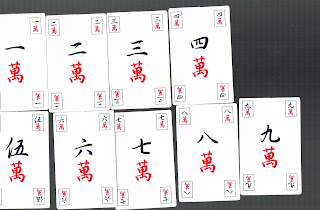The Japanese game of mahjong differs slightly from the versions played in China, HK, and elsewhere. For starters, the game uses only 136 tiles, instead of the 144 or more used elsewhere. These variations are reflected in a pretty little set from that country.
The set presented below is a complete fac-similie of a japanese mahjong set, reproduced on paper. The cards here are closer to the size of mahjong tiles than normal playing cards ( they are only 3 x 5 cm ), and as a result, the set also comes with four card "racks", on which the cards may be held in the game
The suit of coins.
Note the miniature depeictions of the cards used as indices placed in the corners of the cards. Also note that colour black, or rather, a very dark indigo blue, replaces the brilliant blue of other sets
The suit of bamboos-
Note the one of bamboos ( 1st row, 1st from left) The bird depicted here is much more complex than that of the previous examples, resembling a peacock, rather than an abstract jumble of lines resempling a parrot
the suit of 萬
Again, not much removed from the other examples shown
~Other cards, and the back design~
The Dragons ( A ) dislpay small variants from the chinese. For starters, the "發" is written somewhat differntly from the chinese. Secondly, the "白板" here is completely blank, without the "frame" in other examples. However, the makers printed, in a very faint grey , the word 白 on the card ( barely visible in the above img. ), perhaps to prevent it from being mistaken for a spare card.
The Winds ( B) are relatively unexcaptional.
Here is where the differences between Japanese mahjong and the Chinese versions become apparent. Firstly, There are no flowers, as the japanese game usually does not use them. However, in some variants, three cards, known as "red fives" are used. ( C) . They function as special bonuses.
as for D, I know not what it does ( any Trasnlation appreceated) , and E is a yakitori marker- A piece of scoring appartus used in the game.




D is a card with the optional "wareme" (split/crack) rule written on it. When wareme is in effect, the player whose wall was broken (or in this case, whose card rack the initial deal began from) pays and receives double.
ReplyDelete